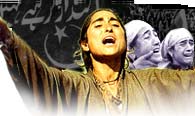Sheikh Abdullah is released in September. On October 22, Pakistani tribesmen enter Kashmir from the Baramulla side.
Maharaja Hari Singh beats a hasty retreat to Jammu. Hurriedly signs the Instrument of Accession. On October 27, Kashmir becomes part of India.
The Indian army repels Pakistani raiders. Sheikh Abdullah becomes prime minister of Kashmir.
1948: India takes the Kashmir problem to the United Nations Security Council and conditionally offers to hold a plebiscite under UN supervision.
On August 13, a UN commission proposes that the state's future be decided by the people. Pakistan accepts the resolution on December 20.
1949: On October 17, the Indian Constituent Assembly adopts Article 370. This ensures special status to Jammu and Kashmir.
1951-52: An interim constitution for the state comes into effect in November. On July 24, an agreement is arrived at between Sheikh Abdullah and the Government of India, providing for the state's autonomy within India.
1953: On August 9, Sheikh Abdullah is dismissed and arrested. Bakshi Ghulam Mohammed becomes prime minister.
1956: The J&K Constituent Assembly adopts a constitution which has a provision to make the state an integral part of the Indian Union.
1963: The holy relic goes missing from the Hazratbal shrine on December 27. Violence and demonstrations spill across the valley.
1964: The holy relic is restored on January 4. Sheikh Abdullah is released from prison. Protest demonstrations are held on December 21 against Articles 356 and 357 of the Indian Constitution being extended to the state.
1965: An Indo-Pak war results after armed Pakistani infiltrators cross the border.
1972: The Simla Agreement, which leaves the door open for Pakistan on Kashmir, is signed on July 2.
1974: The Kashmir Accord is signed on November 3.
1975: Sheikh Abdullah becomes chief minister on February 25.
1977: The Congress withdraws support to Sheikh Abdullah. He resigns on March 27. The assembly is dissolved. The first election in the state is held on June 30. The National Conference wins 47 of the 76 seats.
1982: Sheikh Abdullah dies on September 8. His son Farooq takes over as chief minister.
1983: Farooq Abdullah enjoys a convincing victory.
1984: Jagmohan is appointed governor in April. Farooq Abdullah is dismissed on July 2. His brother-in-law G M Shah is crowned chief minister.
1986: The Shah government is shown the door on March 7. November sees Farooq back in power, aided by a seat-sharing agreement with Rajiv Gandhi. Farooq becomes 'an Indian' to Kashmiris.
1987: The Muslim United Front, comprising various Islamic organisations, is created to take on the Farooq-Rajiv alliance. Despite favourable indications, the MUF loses. Farooq faces allegations of rigging.
1988: Protests and anti-India demonstrations in the valley. The strike against hike in power tariff turns violent. Many killed in police firings.
1989: General K V Krishna Rao becomes governor. Yusuf Halwai, a National Conference worker, is shot dead by militants. The militants kill the first Kashmiri Pandit. Rubaiya Sayeed is kidnapped within days of V P Singh taking over at the Centre. Her release is secured five days later in exchange for five JKLF leaders.
1990: Jagmohan returns as governor on January 19. Farooq resigns. On January 20, more than 100 people are killed by security personnel in the Gawakadal massacre. In March largescale migration of Pandits from the valley.
On May 21, Mirwaiz Maulvi Farooq is shot dead. Security forces fire upon his funeral procession. Over 50 are killed. Jagmohan loses his job. Girish Chandra Saxena, a former head of the Research and Analysis Wing, takes over as governor.
1991: The violence continues. Armed militants become common sight in downtown Srinagar.
1992: On January 26, the Bharatiya Janata Party's Ekta Yatra hoists the national flag in Lal Chowk under massive security. There is a curfew on.
Violence spreads to areas of Jammu province like Doda. Allegations of human rights violations by security forces increase.
1993: In January, 40 people are killed in Sopore by security forces. Part of the town is burnt down after two security personnel are killed.
In March, General K V Krishna Rao returns as governor.
April sees the state police on strike after a constable, Riyaz Ahmed, is killed in army custody.
In October, the Hazratbal crisis occurs. Army surrounds militants hiding inside the shrine. In a related incident, 60 people are killed in Bij Bihara.
1994: Prime Minister P V Narasimha Rao releases militant leaders like Yasin Malik and Shabir Shah.
1995: The Charar-e-Sharief siege. The infamous Mast Gul and a coterie take shelter in the shrine. The army surrounds it. On May 10, Gul and companions allegedly set fire to the shrine while escaping.
The peak of militancy is past. Security personnel have an upper hand. General K V Krishna Rao pushes for an assembly election.
1996: Elections finally happen. Farooq Abdullah wins. Prime Minister H D Deve Gowda shows some interest in the Kashmir conflict. But nothing concrete comes of it.
1997: Farooq Abdullah rules on. His return is touted as the return of normalcy. Violence and encounters continue, but tourists start trickling in.
1998: Government says it is safe for Pandits to come back. The Wandhama massacre occurs. 23 Pandits are killed in a village 30 km outside Srinagar. The return of Pandits seems more distant.
G C Saxena returns for a second term as governor. Encounters, blasts and violence continue.
1999: In the initial months of the year, both the Centre and state claims that Kashmir is fast on the way to peace. There is a healthy tourist flow to the valley. But the Kargil conflict spoils it all.
The Lok Sabha election proves that Kashmir is still in anti-India mode. The voter turnout is poor. The polls also bring up fresh allegations of rigging against Farooq Abdullah.
A fresh wave of violence erupts. A series of hits on army camps, the most notable of them being the November 3 attack on the 15 Corps headquarters in Srinagar. Many Kashmiris now say the situation is worse than what it ever was.



